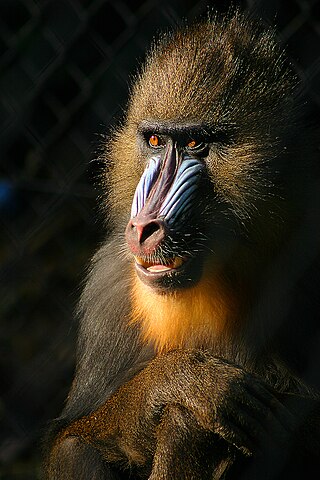
Lemuriformes is the sole extant infraorder of primate that falls under the suborder Strepsirrhini. It includes the lemurs of Madagascar, as well as the galagos and lorisids of Africa and Asia, although a popular alternative taxonomy places the lorisoids in their own infraorder, Lorisiformes.

Plesiadapis is one of the oldest known primate-like mammal genera which existed about 58–55 million years ago in North America and Europe. Plesiadapis means "near-Adapis", which is a reference to the adapiform primate of the Eocene period, Adapis. Plesiadapis tricuspidens, the type specimen, is named after the three cusps present on its upper incisors.

The rhinarium is the furless skin surface surrounding the external openings of the nostrils in many mammals. Commonly it is referred to as the tip of the snout, and breeders of cats and dogs sometimes use the term nose leather. Informally, it may be called a "truffle", "wet snout," or "wet nose” because its surface is moist in some species: for example, healthy dogs and cats.

Lorisoidea is a superfamily of nocturnal primates found throughout Africa and Asia. Members include the galagos and the lorisids. As strepsirrhines, lorisoids are related to the lemurs of Madagascar and are sometimes included in the infraorder Lemuriformes, although they are also sometimes placed in their own infraorder, LorisiformesGregory, 1915.

Papionini is a tribe of Old World monkeys that includes several large monkey species, which include the macaques of North Africa and Asia, as well as the baboons, geladas, mangabeys, kipunji, drills, and mandrills, which are essentially from sub-Saharan Africa. It is typically divided into two subtribes: Macacina for the genus Macaca and its extinct relatives and the Papionina for all other genera.

Indopithecus giganteus is an extinct species of large ape that lived in the late Miocene of the Siwalik Hills in northern India. Although frequently assigned to the more well-known genus Gigantopithecus, recent authors consider it to be a distinct genus in its own right.

Dinopithecus is an extinct genus of very large primates closely related to baboons, that lived during the Pliocene and Pleistocene epochs in South Africa and Ethiopia. It was named by British paleontologist Robert Broom in 1937. The only species currently recognized is Dinopithecus ingens, as D. quadratirostris has been reassigned to the genus Soromandrillus. It is known from several infilled cave sites in South Africa, all of early Pleistocene age, including Skurweberg, Swartkrans, and Sterkfontein.

Anaptomorphinae is a pre-historic group of primates known from Eocene fossils in North America and Europe and later periods of Paleocene Asia, and are a sub-family of omomyids. The anaptomorphines is a paraphyletic group consisting of the two tribes Trogolemurini and Anaptomorphini. Anaptomorphine radiation in Wyoming, one of the most detailed records of changes within populations and between species in the fossil record, has provided remarkable evidence of transitional fossils.
Mazateronodon is a genus of adapiform primate that lived in Europe during the middle Eocene.
Hoanghoniinae is a subfamily of adapiform primate that lived in Asia during the middle to late Eocene.
Kyitchaungia is a genus of adapiform primate that lived in Asia during the Eocene.
Paukkaungia is a genus of adapiform primate that lived in Asia during the Eocene.
Omanodon is a genus of primate related to lemuriforms that lived in Oman during the early Oligocene.
Shizarodon is a genus of primate related to lemuriforms that lived in Oman during the early Oligocene.
Notnamaia is a genus of primates that lived in Africa during the early middle Eocene. It contains one species, N. bogenfelsi. Its describers considered it to be an early simian, but other researchers have generally placed it within Strepsirrhini, possibly aligned with the djebelemurids or caenopithecines.
Muangthanhinius is a genus of adapiform primate that lived in Asia during the late Eocene.
Asiadapinae is a subfamily within the extinct primate family Notharctidae found in Asia during the early Eocene. They were very small and were some of the earliest adapiforms, similar to cercamoniines but also sharing features with sivaladapids.
Magnadapis is a genus of adapiform primate that lived in Europe during the late Eocene.
Propliopithecoidea is a superfamily of catarrhine primates that inhabited Africa and the Arabian Peninsula during the Early Oligocene about 32 to 29 million years ago. Fossils have been found in Egypt, Oman and Angola. They are one of the earliest known families of catarrhines. They have a number of features in common with extant catarrhines, but also features that are primitive and not found in later catarrhine families.









